(pictures: ctto)
Die Caps
A die cap is caused when a struck coin sticks to the upper hammer die. Once the coin is stuck to the die face, the reverse of the struck coin becomes the new die face. When the next blank is fed into the collar and the strike occurs, the reverse design of the adheared struck coin impresses itself into the new blank. This struck coin is a brockage strike. The coin that adhered to the upper die is known as a die cap. This process repeats itself as more coins are struck by the cap. The greater the number of strikes, the higher the cap metal will be pushed around the upper die shaft. Eventually, the cap brakes away from the die in the shape of a thimble.
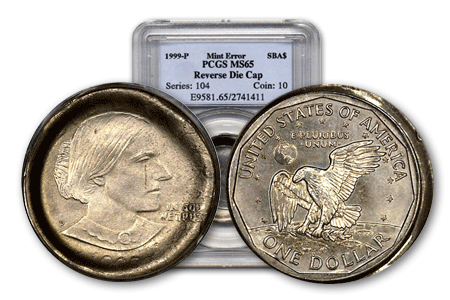

Capped die strike
When a die cap error is occurring, the dies continue to strike more coins even though a coin is capped around one of the dies. If the coin is capped around the obv. die, the coins stuck with that die will appear blank or have varying degrees of mushyness on the obv. due to the obverse die being obstructed. If the cap stays on indefinitely, eventually it will wear through the planchet and the coins struck by that die will become less and less obstructed causing a "late-stage" capped die strike where the image is less distorted.

Wrong Planchet / Off-Metal Errors
Wrong planchet and off-metal errors occur when a correctly made blank from one denomination is accidentaly fed into a press for another denomination. Examples are a nickel struck on a cent planchet and a cent struck on a dime planchet. The coin struck on an incorrect blank will weigh exactly what the denomination of that blank would have been. An even more dramatic wrong planchet error is a coin struck on a previously struck coin of a different metal.
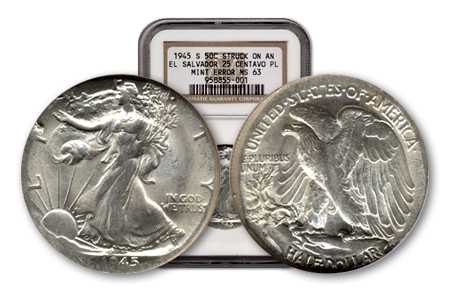
Off-Center Struck Coins
Off-center coins are one of the most common and best known types of errors. This happens when a blank which is supposed to be fed into the press, lands in the collar improperly. When this occurs only part of the blank is between the upper and lower dies. When the dies strike the blank, only that part will be struck with a design.
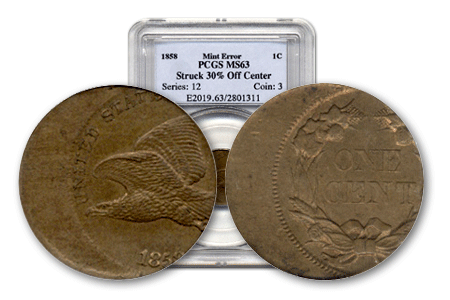
Broadstrikes
A broadstruck error occurs when a coin is struck without the collar to form the rim and edge that is part of the shape of the coin. Coins can be broadstruck on either type one or type two planchets. When a coin is broadstruck the blank being fed into the collar will spread and distort outward as it is being struck because the collar isn't in the correct position to retain it.
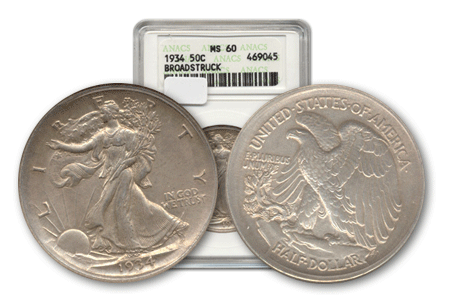
Partial Collars
Partial collar strikes occur when there is a malfunction of the striking press. This causes the collar to be in an incorrect position. The lower die (usually the reverse die) is recessed in the collar. This allows the coin which is going to be struck to have a formed rim. After a coin is struck the lower die raises upwards, pushing the struck coin out of the collar and ejecting it.
If a blank entering the collar is not properly seated, it will only have partial reeding as it is struck. The edge of this coin will have a partial reeding and a partial blank surface area. Recently, the Mint has installed new machinery where either die can be installed in either position.
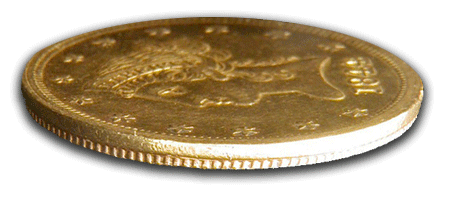
Uniface Strikes
Uniface coins occur when there have been two blank planchets in the press at the same time. The other blank will obstruct the die on either the obverse or reverse side, which will prevent it from having that design on the coin. There are many different variations involving uniface errors. In addition to having a 100% blank obverse or reverse, a coin can be struck off-center, with a blank planchet in the collar which will obstruct one side of the off-center. There are also mated pairs which have a combination of multiple errors which can include a side which is uniface. Finally, there are uniface strikes due to a die cap which adhered to the die, forming itself in the shape of a die and striking blank planchets.
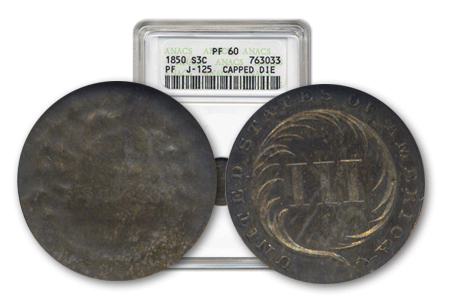
Brockages
A brockage error can only occur when there are two coins involved. One of the coins involved will always be a struck coin which has not ejected properly. That struck coin will find its way back between the dies and will be struck next to a blank planchet which was fed into the collar. The image of that first struck coin will be impressed into that side of the blank planchet. The result will be a second coin which has images of the first coin impressed into it. Those images will be pressed into the coin and the image will be in reverse. This incuse sunken image is known as a brockage.
Occurs the same as an indent, except that a struck coin is struck into a blank planchet leaving a mirror image impression, although often quite distorted due to metal flow.
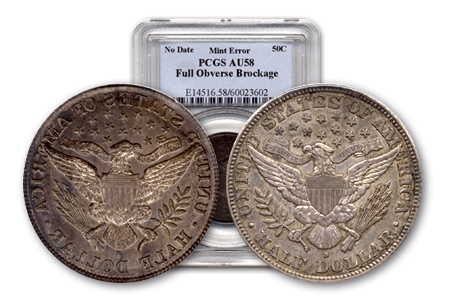
Double and Triple Struck Coins
When a blank planchet is struck by the dies, the normal procedure is for the feeders to eject the struck coin out of the collar and into a chute. If there is a malfunction and the struck coin isn't ejected, it may receive a second or third strike by the dies. A multiple struck coin can happen in many ways and have many combinations of errors.
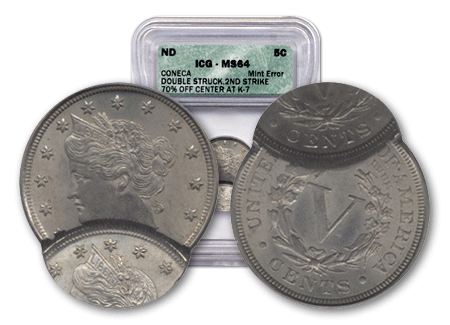
Indents
An indent error occurs when two blanks are fed inadvertently into the same collar, with one blank partly overlaying on top of the other. When the hammer die strikes this combination, the upper blank will be forced into the lower blank, creating a depression which is shaped similar to the upper blank. A scarce type of indent occurs when a blank intended for one denomination lands on top of a blank from a different denomination.
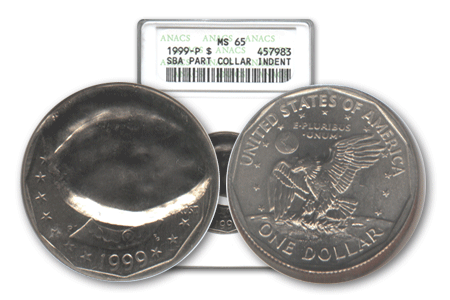
Die Adjustment Strikes
Die adjustment strikes are also known as die trials. This error occurs when a coin is struck from the press with very little pressure. When the press is being set up and adjusted, extremely weak strikes occur as the strike pressure reaches its optimum level. These die trials are destroyed after being struck and are rarely found in circulation.
The coin featured above is one of four known die trials for the entire Peace Dollar series.

Double Denomination Errors
One of the most expensive, popular, and desired types of errors are the double denominations. This error happens when a coin is struck on a previously struck coin of a smaller denomination. Examples are a cent on a struck dime, and a nickel on a struck cent. The most dramatic are those with considerable design visible from the original strike. There are a few known double denominations with different dates.

Counterbrockages
A counterbrockage error involves a cap die and a previously struck coin. When a cap die strikes a previously struck coin, the obverse design from that struck coin will be impressed into the cap. The result will be a design where the cap face will be an incuse brockage. When a new blank is struck by this cap die with an incuse brockage image, the obverse will have a raised and spread image from that incuse design of the cap. This brockage impression is known as a counterbrockage.

Transitional Errors
A transitional error occurs when a coin is struck on a planchet from a previous year with different metal composition. The most famous transitional is a 1943 copper cent struck on a 1942 copper blank. 1943 cents were struck in steel because of the copper shortage during World War II. Other famous transitionals include 1965 coinage struck in silver instead of clad.
There are also transitionals struck on blanks for the next year. An example is 1964 coinage in clad instead of silver. Most recently, transitionals were discovered involving the SBA and Sacagawea Dollars of 1999 and 2000. There are eight known 1999 SBA Dollars struck on the brass planchet for the 2000 Sacagawea Dollar, and four known 2000 Sacagawea Dollars struck on a clad planchet for the 1999 SBA Dollar.
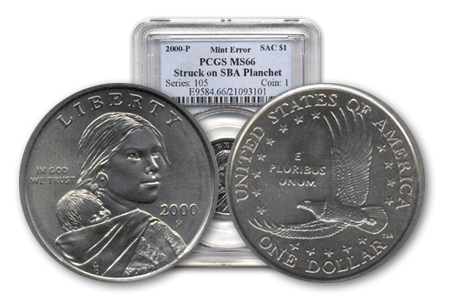
Struck Fragments
The blanking press takes the coils of metal strips and punches blanks out of it, ejecting the webbing at the other end. The webbing is cut into small scrap pieces to be melted and recycled. Occasionally a scrap piece will be mixed with the blank planchets and struck by the dies. Struck fragments are rare in the larger denominations. These can be uniface or die struck both sides and are very rare on type coins.
The Liberty Head Nickel featured above was struck on scrap and is the only known fragment in the Liberty Head Nickel series.
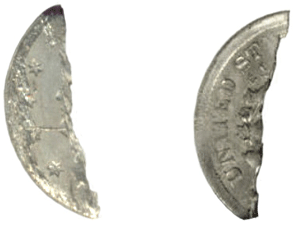
Missing Edge Lettering
A mint error has been discovered on the new Presidential Dollars. These coins inadvertently left the United States Mint without edge-lettering on them. The inscriptions ‘In God We Trust,’ ‘E Pluribus Unum,’ as well as the mint mark and year are absent from these errors.
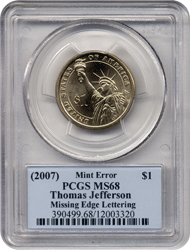
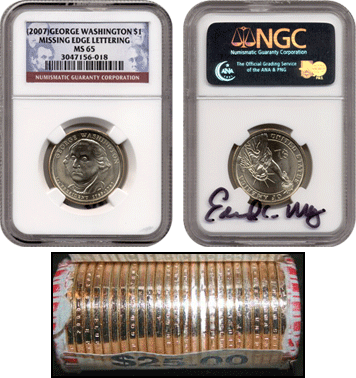
Mechanical Doubling /Machine Doubling
Often looks like a doubled die but is not. It is caused by loose dies that twist slightly after coming into contact with the planchet causing the die to slightly drag on the coin producing a flat, shelf-like doubled appearance. Also under this classification is excessive die wear and/or improper die annealing that will cause the elements of the design to appear doubled simply because the lettering and design elements are thick and mushy. Mechanical doubling usually commands very little premium. Be especially careful of this error on 1969-S cents which can sometimes be mistaken for the very rare and valuable 1969-S doubled die cent.

Die Break
A chip out of the die into which metal from the planchet will flow when the die strikes coins. It appears as a raised blob of metal on the struck coins. When the die break is large it is sometimes called a "cud."
When a significant part of the edge of the die deteriorates and falls off. The coins struck with this die exhibit a raised blank area on that part of the design. Sometimes called "major die break"

Struck through error
Occurs when a foreign object lies on top of the planchet and leaves an impression of itself when struck into the coin. A wide variety of objects have been reported including grease, string, cloth, hair, plastic, bandaid, staples, etc.

Weak strike or Die trial
Occurs when there is insufficient pressure from the dies to leave a full impression on the planchet. This can occur for a variety of reasons but usually occurs when the power to the presses is turned off and the dies continue to strike coins with less and less pressure until coming to a stop. On such coins all the detail, including the reeding on clad coins should exhibit extreme weakness. If the coin is simply struck through grease, some details may be strong and the edge reading will also be strong.

Curved Clipped Planchet
Planchets are punched from large thin metal sheets. After a section of the sheet is punched, if the sheet fails to be fed far enough ahead, the punch will overlap an already punched area causing that planchet to have a circular "clip" of missing metal. A good way to tell if the coin is an error or simply damage that occurred outside the mint is to look for signs of metal flow into the blank area, which indicates a genuine clip. This will appear as weakness and thinness around the missing metal. There will also often be a corresponding area of weakness on the rim of the opposite side of the coin, known as the "Blakesley effect." A genuine clip will never show a raised edge of metal bordering the missing metal (which usually indicates shearing) and the details bordering the area of missing metal should not be crisp.
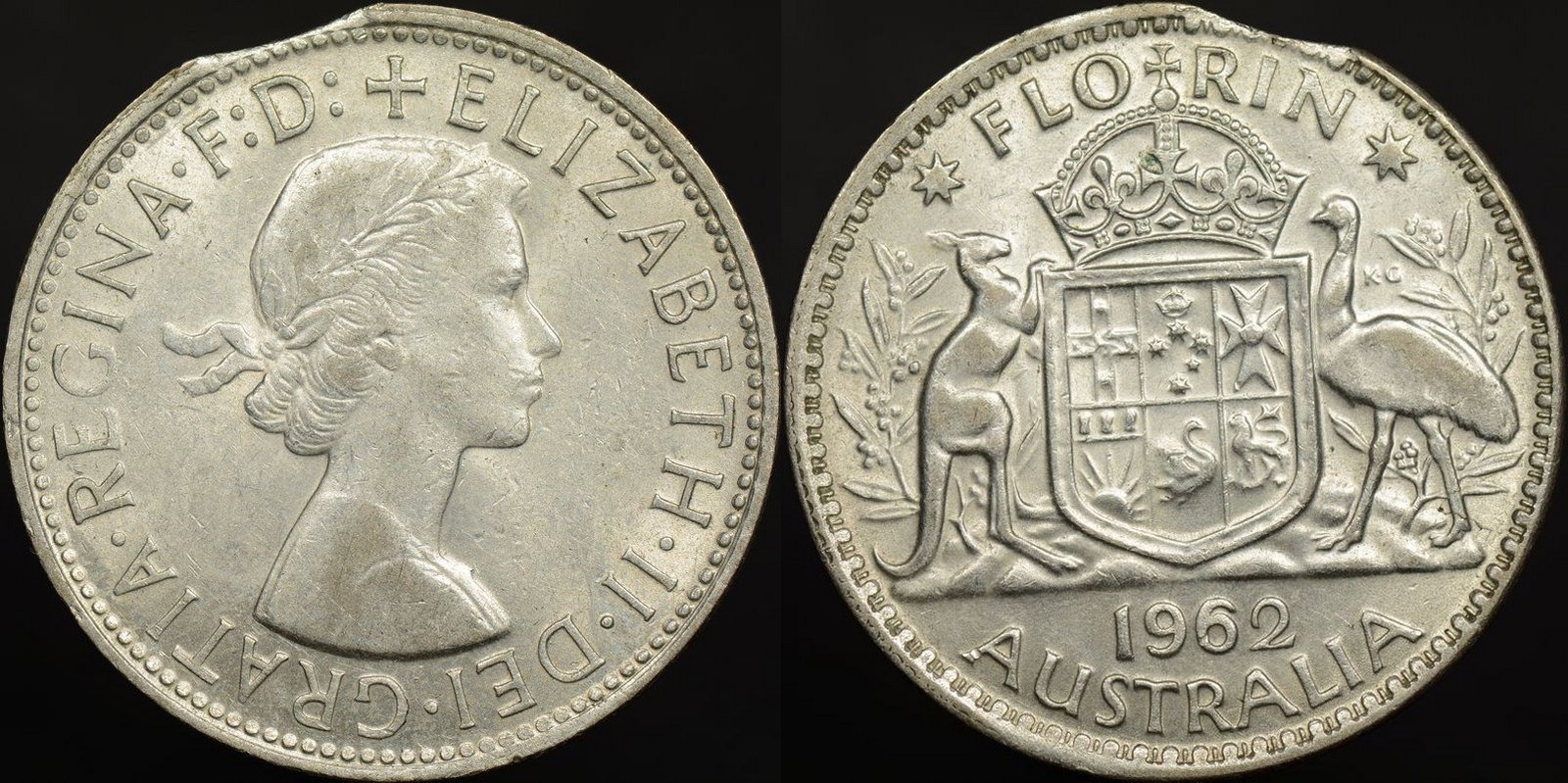
Straight clipped planchet
If the metal strip shifts during the punching process and the punches overlap the straight side edge of the strip, a straight area of metal will be missing from the planchet.


Clashed dies
Occurs when there is a malfunction in the planchet feeding mechanism and no planchet is fed into the striking chamber allowing the dies to strike each other. The obv. die will leave an impression in the rev. die and vice versa. Coins struck with these dies will exhibit details of both the obv and rev. on each side of the coin. The amount of detail can vary from barely discernable to very noticeable.


Lamination


Split Planchet Error
If the impurity is severe enough, it can case the planchet to split into two halves obv. and rev. If the planchet splits before the strike, the resulting coin will be thin and have detail on both sides but often intermingled with rough striations from the impurities. If the planchet splits after the strike, one side will have full detail and the other side will be blank and striated. In either case the coin will be thin.
Separation errors are bonding errors, not alloy errors. A coin struck on a split planchet will always weigh less than a normal coin. A coin struck on a split-before-strike planchet will show a pattern of striations on the split face.

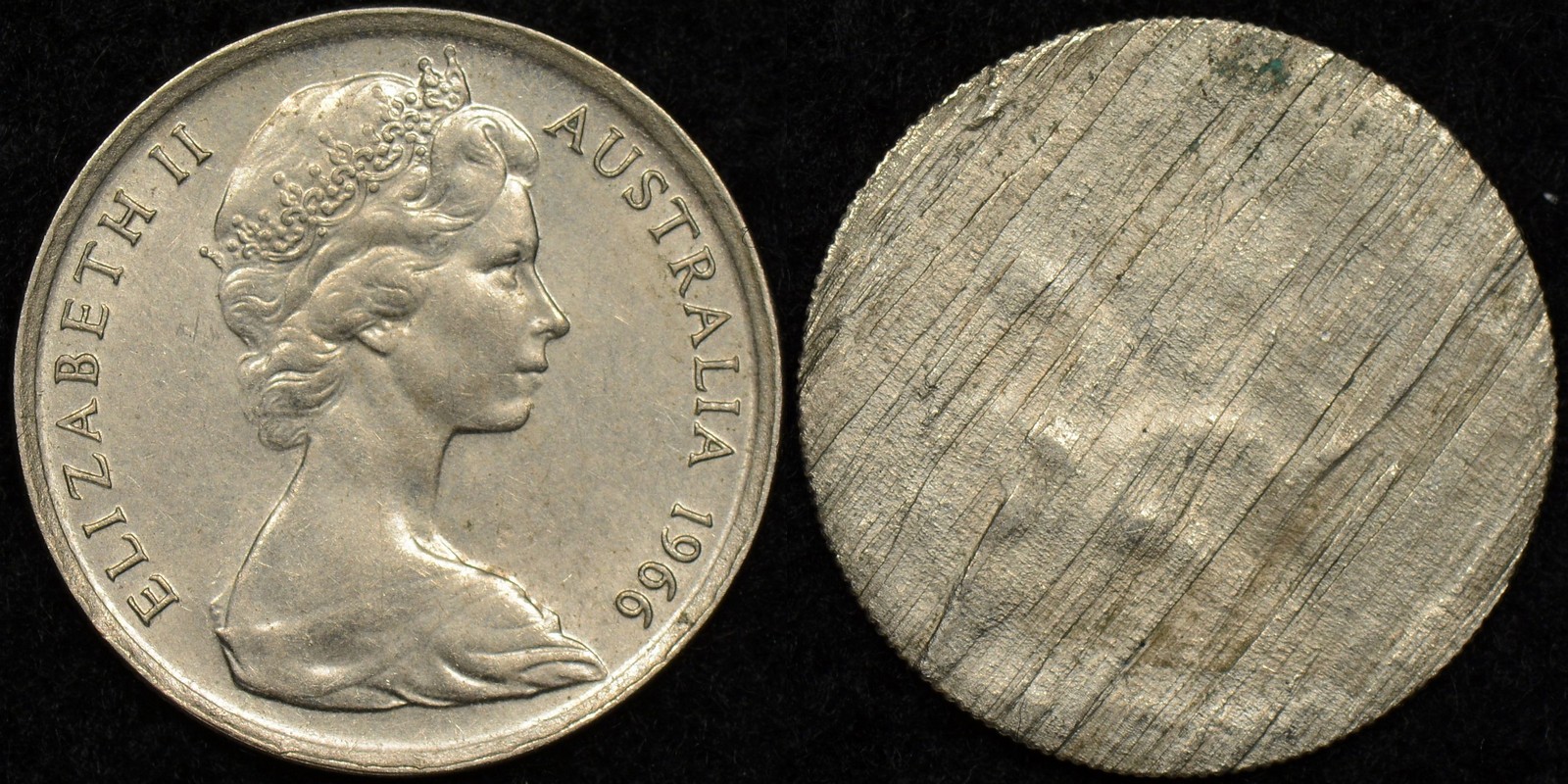
Missing Clad Layer
A clad coin with one of the clad layers missing either before the coin is struck or which is loose and falls away after the strike. The side of the coin with the clad layer missing will be copper colored showing the exposed copper core of the coin. The other side of the coin is normal.


Double Strike
If a coin fails to be properly ejected from the striking chamber after being stuck and the dies come down again to strike the coin again, a double strike ocurs. Double strikes can occur with the second strike off center or on-center. In the same way triple and multiply struck coins occur.


Dryer Coins
This term is used in reference to abused coins that have tumbled around the fins of an industrial dryer. The obverse and reverse designs have been pummeled into mush. Some metal has been relocated from the edge and design rim onto the field and peripheral letters in the form of a thin apron. The apron forms a complete ring that lies loosely on each face.
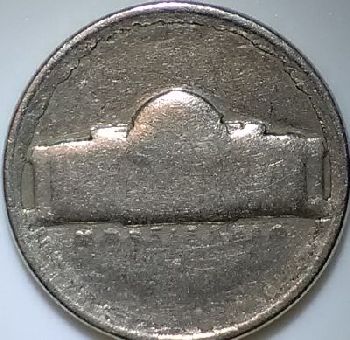
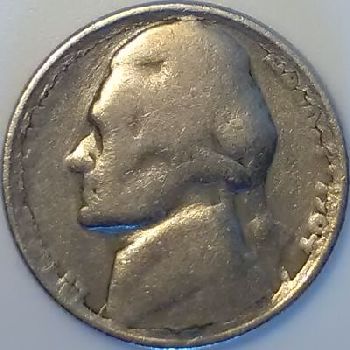
Die Caps
A die cap is caused when a struck coin sticks to the upper hammer die. Once the coin is stuck to the die face, the reverse of the struck coin becomes the new die face. When the next blank is fed into the collar and the strike occurs, the reverse design of the adheared struck coin impresses itself into the new blank. This struck coin is a brockage strike. The coin that adhered to the upper die is known as a die cap. This process repeats itself as more coins are struck by the cap. The greater the number of strikes, the higher the cap metal will be pushed around the upper die shaft. Eventually, the cap brakes away from the die in the shape of a thimble.
Sample:

Capped die strike
When a die cap error is occurring, the dies continue to strike more coins even though a coin is capped around one of the dies. If the coin is capped around the obv. die, the coins stuck with that die will appear blank or have varying degrees of mushyness on the obv. due to the obverse die being obstructed. If the cap stays on indefinitely, eventually it will wear through the planchet and the coins struck by that die will become less and less obstructed causing a "late-stage" capped die strike where the image is less distorted.

Wrong Planchet / Off-Metal Errors
Wrong planchet and off-metal errors occur when a correctly made blank from one denomination is accidentaly fed into a press for another denomination. Examples are a nickel struck on a cent planchet and a cent struck on a dime planchet. The coin struck on an incorrect blank will weigh exactly what the denomination of that blank would have been. An even more dramatic wrong planchet error is a coin struck on a previously struck coin of a different metal.

Off-Center Struck Coins
Off-center coins are one of the most common and best known types of errors. This happens when a blank which is supposed to be fed into the press, lands in the collar improperly. When this occurs only part of the blank is between the upper and lower dies. When the dies strike the blank, only that part will be struck with a design.

Broadstrikes
A broadstruck error occurs when a coin is struck without the collar to form the rim and edge that is part of the shape of the coin. Coins can be broadstruck on either type one or type two planchets. When a coin is broadstruck the blank being fed into the collar will spread and distort outward as it is being struck because the collar isn't in the correct position to retain it.

Partial collar strikes occur when there is a malfunction of the striking press. This causes the collar to be in an incorrect position. The lower die (usually the reverse die) is recessed in the collar. This allows the coin which is going to be struck to have a formed rim. After a coin is struck the lower die raises upwards, pushing the struck coin out of the collar and ejecting it.
If a blank entering the collar is not properly seated, it will only have partial reeding as it is struck. The edge of this coin will have a partial reeding and a partial blank surface area. Recently, the Mint has installed new machinery where either die can be installed in either position.

Uniface Strikes
Uniface coins occur when there have been two blank planchets in the press at the same time. The other blank will obstruct the die on either the obverse or reverse side, which will prevent it from having that design on the coin. There are many different variations involving uniface errors. In addition to having a 100% blank obverse or reverse, a coin can be struck off-center, with a blank planchet in the collar which will obstruct one side of the off-center. There are also mated pairs which have a combination of multiple errors which can include a side which is uniface. Finally, there are uniface strikes due to a die cap which adhered to the die, forming itself in the shape of a die and striking blank planchets.

Brockages
A brockage error can only occur when there are two coins involved. One of the coins involved will always be a struck coin which has not ejected properly. That struck coin will find its way back between the dies and will be struck next to a blank planchet which was fed into the collar. The image of that first struck coin will be impressed into that side of the blank planchet. The result will be a second coin which has images of the first coin impressed into it. Those images will be pressed into the coin and the image will be in reverse. This incuse sunken image is known as a brockage.
Occurs the same as an indent, except that a struck coin is struck into a blank planchet leaving a mirror image impression, although often quite distorted due to metal flow.

Double and Triple Struck Coins
When a blank planchet is struck by the dies, the normal procedure is for the feeders to eject the struck coin out of the collar and into a chute. If there is a malfunction and the struck coin isn't ejected, it may receive a second or third strike by the dies. A multiple struck coin can happen in many ways and have many combinations of errors.

Indents
An indent error occurs when two blanks are fed inadvertently into the same collar, with one blank partly overlaying on top of the other. When the hammer die strikes this combination, the upper blank will be forced into the lower blank, creating a depression which is shaped similar to the upper blank. A scarce type of indent occurs when a blank intended for one denomination lands on top of a blank from a different denomination.

Die adjustment strikes are also known as die trials. This error occurs when a coin is struck from the press with very little pressure. When the press is being set up and adjusted, extremely weak strikes occur as the strike pressure reaches its optimum level. These die trials are destroyed after being struck and are rarely found in circulation.
The coin featured above is one of four known die trials for the entire Peace Dollar series.

Double Denomination Errors
One of the most expensive, popular, and desired types of errors are the double denominations. This error happens when a coin is struck on a previously struck coin of a smaller denomination. Examples are a cent on a struck dime, and a nickel on a struck cent. The most dramatic are those with considerable design visible from the original strike. There are a few known double denominations with different dates.

Counterbrockages
A counterbrockage error involves a cap die and a previously struck coin. When a cap die strikes a previously struck coin, the obverse design from that struck coin will be impressed into the cap. The result will be a design where the cap face will be an incuse brockage. When a new blank is struck by this cap die with an incuse brockage image, the obverse will have a raised and spread image from that incuse design of the cap. This brockage impression is known as a counterbrockage.

Transitional Errors
A transitional error occurs when a coin is struck on a planchet from a previous year with different metal composition. The most famous transitional is a 1943 copper cent struck on a 1942 copper blank. 1943 cents were struck in steel because of the copper shortage during World War II. Other famous transitionals include 1965 coinage struck in silver instead of clad.
There are also transitionals struck on blanks for the next year. An example is 1964 coinage in clad instead of silver. Most recently, transitionals were discovered involving the SBA and Sacagawea Dollars of 1999 and 2000. There are eight known 1999 SBA Dollars struck on the brass planchet for the 2000 Sacagawea Dollar, and four known 2000 Sacagawea Dollars struck on a clad planchet for the 1999 SBA Dollar.

Struck Fragments
The blanking press takes the coils of metal strips and punches blanks out of it, ejecting the webbing at the other end. The webbing is cut into small scrap pieces to be melted and recycled. Occasionally a scrap piece will be mixed with the blank planchets and struck by the dies. Struck fragments are rare in the larger denominations. These can be uniface or die struck both sides and are very rare on type coins.
The Liberty Head Nickel featured above was struck on scrap and is the only known fragment in the Liberty Head Nickel series.

Missing Edge Lettering
A mint error has been discovered on the new Presidential Dollars. These coins inadvertently left the United States Mint without edge-lettering on them. The inscriptions ‘In God We Trust,’ ‘E Pluribus Unum,’ as well as the mint mark and year are absent from these errors.


Mechanical Doubling /Machine Doubling
Often looks like a doubled die but is not. It is caused by loose dies that twist slightly after coming into contact with the planchet causing the die to slightly drag on the coin producing a flat, shelf-like doubled appearance. Also under this classification is excessive die wear and/or improper die annealing that will cause the elements of the design to appear doubled simply because the lettering and design elements are thick and mushy. Mechanical doubling usually commands very little premium. Be especially careful of this error on 1969-S cents which can sometimes be mistaken for the very rare and valuable 1969-S doubled die cent.

Die Break
A chip out of the die into which metal from the planchet will flow when the die strikes coins. It appears as a raised blob of metal on the struck coins. When the die break is large it is sometimes called a "cud."


Curved Clipped Planchet
Planchets are punched from large thin metal sheets. After a section of the sheet is punched, if the sheet fails to be fed far enough ahead, the punch will overlap an already punched area causing that planchet to have a circular "clip" of missing metal. A good way to tell if the coin is an error or simply damage that occurred outside the mint is to look for signs of metal flow into the blank area, which indicates a genuine clip. This will appear as weakness and thinness around the missing metal. There will also often be a corresponding area of weakness on the rim of the opposite side of the coin, known as the "Blakesley effect." A genuine clip will never show a raised edge of metal bordering the missing metal (which usually indicates shearing) and the details bordering the area of missing metal should not be crisp.

Straight clipped planchet
If the metal strip shifts during the punching process and the punches overlap the straight side edge of the strip, a straight area of metal will be missing from the planchet.
Ragged clipped planchet
If the punches overlap the ragged ends of the strip, a resulting ragged area of missing metal occurs.
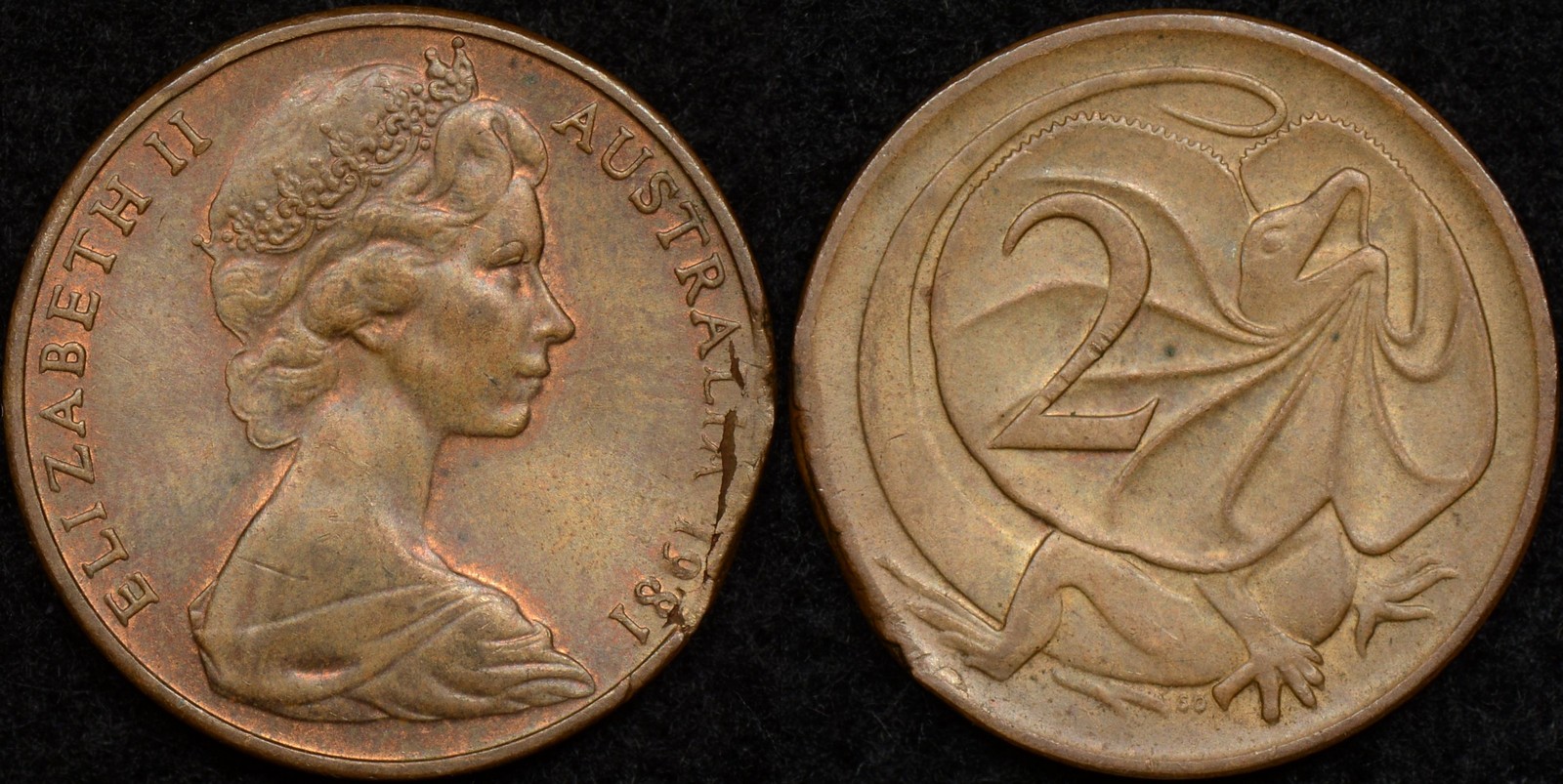
Wrong planchet/off metal
When a planchet is struck by a pair of dies that do not correspond to the denomination intended for the planchet, a wrong planchet error occurs. For example a Jefferson nickel struck on a cent planchet will have the same weight and copper composition as a cent. It will likely be smaller than a nickel, but probably slightly larger than a cent because the nickel collar cannot restrain the smaller cent planchet from expanding.
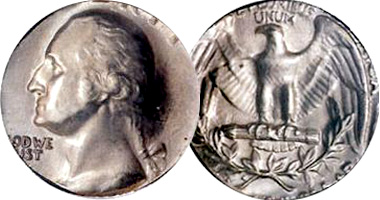
If the punches overlap the ragged ends of the strip, a resulting ragged area of missing metal occurs.

Wrong planchet/off metal
When a planchet is struck by a pair of dies that do not correspond to the denomination intended for the planchet, a wrong planchet error occurs. For example a Jefferson nickel struck on a cent planchet will have the same weight and copper composition as a cent. It will likely be smaller than a nickel, but probably slightly larger than a cent because the nickel collar cannot restrain the smaller cent planchet from expanding.


Clashed dies
Occurs when there is a malfunction in the planchet feeding mechanism and no planchet is fed into the striking chamber allowing the dies to strike each other. The obv. die will leave an impression in the rev. die and vice versa. Coins struck with these dies will exhibit details of both the obv and rev. on each side of the coin. The amount of detail can vary from barely discernable to very noticeable.

Lamination
Dirt and impurities in the metal of the planchet can manifest themselves as cracks and peels on the struck coin.

Split Planchet Error
If the impurity is severe enough, it can case the planchet to split into two halves obv. and rev. If the planchet splits before the strike, the resulting coin will be thin and have detail on both sides but often intermingled with rough striations from the impurities. If the planchet splits after the strike, one side will have full detail and the other side will be blank and striated. In either case the coin will be thin.
Separation errors are bonding errors, not alloy errors. A coin struck on a split planchet will always weigh less than a normal coin. A coin struck on a split-before-strike planchet will show a pattern of striations on the split face.

Missing Clad Layer
A clad coin with one of the clad layers missing either before the coin is struck or which is loose and falls away after the strike. The side of the coin with the clad layer missing will be copper colored showing the exposed copper core of the coin. The other side of the coin is normal.

Double Strike
If a coin fails to be properly ejected from the striking chamber after being stuck and the dies come down again to strike the coin again, a double strike ocurs. Double strikes can occur with the second strike off center or on-center. In the same way triple and multiply struck coins occur.


Dryer Coins
This term is used in reference to abused coins that have tumbled around the fins of an industrial dryer. The obverse and reverse designs have been pummeled into mush. Some metal has been relocated from the edge and design rim onto the field and peripheral letters in the form of a thin apron. The apron forms a complete ring that lies loosely on each face.


Sample Picture:


No comments:
Post a Comment